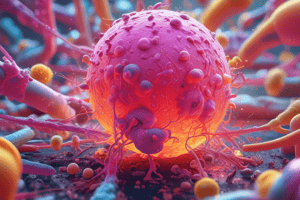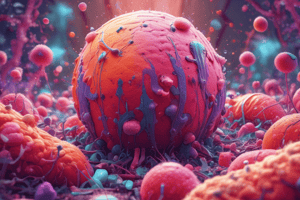Podcast
Questions and Answers
How can microbial disinfection be achieved with a thermal washer-disinfector?
How can microbial disinfection be achieved with a thermal washer-disinfector?
- By adjusting the pH level accordingly
- By choosing the appropriate chemical disinfectant
- By monitoring the length of time at a specific temperature (correct)
- By increasing the concentration of the disinfectant
What factors affect the effectiveness of chemical disinfection?
What factors affect the effectiveness of chemical disinfection?
- The color of the disinfectant
- Type of washer-disinfector used
- Initial number of microbes present, temperature, pH, and concentration (correct)
- The level of humidity in the environment
Where is chemical disinfection most commonly used as a primary method?
Where is chemical disinfection most commonly used as a primary method?
- Pharmacy departments
- CSSD settings
- Radiology rooms
- Endoscopy units (correct)
How is the adequacy of chemical disinfection processes typically confirmed?
How is the adequacy of chemical disinfection processes typically confirmed?
What does disinfection aim to achieve on inanimate objects?
What does disinfection aim to achieve on inanimate objects?
What hazardous property is associated with mixing bleach and ammonia?
What hazardous property is associated with mixing bleach and ammonia?
Which of the following is NOT a characteristic of process chemicals according to the Association for the Advancement of Medical Instrumentation (AAMI)?
Which of the following is NOT a characteristic of process chemicals according to the Association for the Advancement of Medical Instrumentation (AAMI)?
Which factor should be considered when choosing process chemicals for medical device decontamination?
Which factor should be considered when choosing process chemicals for medical device decontamination?
What should be determined by the manufacturer's instructions for use (IFU) and validated during commissioning?
What should be determined by the manufacturer's instructions for use (IFU) and validated during commissioning?
Which of the following is NOT recommended when handling and storing process chemicals?
Which of the following is NOT recommended when handling and storing process chemicals?
What is the minimum treatment recommended for reprocessing medical devices that cannot be sterilized?
What is the minimum treatment recommended for reprocessing medical devices that cannot be sterilized?
Where is low-level disinfection recommended to be used for reprocessed medical devices?
Where is low-level disinfection recommended to be used for reprocessed medical devices?
How does drying contribute to the reprocessing of medical devices?
How does drying contribute to the reprocessing of medical devices?
What should be avoided as a drying agent for reprocessed medical devices?
What should be avoided as a drying agent for reprocessed medical devices?
What is the main agent that affects cleaning of used surgical devices prior to sterilization?
What is the main agent that affects cleaning of used surgical devices prior to sterilization?
What is the most important factor to consider when selecting the water quality for the cleaning process?
What is the most important factor to consider when selecting the water quality for the cleaning process?
Which of the following water quality factors can lead to corrosion of medical devices during reprocessing?
Which of the following water quality factors can lead to corrosion of medical devices during reprocessing?
Which of the following personal protective equipment (PPE) measures should be taken when handling chemicals such as detergents, rinse aids, and disinfectants?
Which of the following personal protective equipment (PPE) measures should be taken when handling chemicals such as detergents, rinse aids, and disinfectants?
What is the purpose of the water quality considerations in the cleaning process?
What is the purpose of the water quality considerations in the cleaning process?
Flashcards are hidden until you start studying
Study Notes
Microbial Disinfection with Thermal Washer-Disinfector
- Achieves microbial disinfection by utilizing high temperatures to denature proteins and destroy microorganisms.
Factors Affecting Chemical Disinfection Effectiveness
- Concentration of the chemical agent influences potency and the chance of successful microbial kill.
- Contact time between the disinfectant and the surface plays a critical role in effectiveness.
- Presence of organic matter can inhibit disinfectant action by shielding microbes.
- Temperature and pH can affect the activity and stability of chemical disinfectants.
Primary Usage of Chemical Disinfection
- Commonly employed as the primary disinfection method in healthcare settings for surfaces and medical instruments.
Confirmation of Chemical Disinfection Process Adequacy
- Typically confirmed through biological indicators that demonstrate the reduction of viable microbial populations.
Objectives of Disinfection on Inanimate Objects
- Aims to significantly reduce or eliminate pathogenic microorganisms to ensure safety and prevent infection transmission.
Hazardous Property of Mixing Bleach and Ammonia
- Produces toxic chloramines, which can cause respiratory issues and other severe health risks.
Characteristics of Process Chemicals According to AAMI
- Chemicals must not contain harmful properties that could pose risks during handling and application.
Considerations for Choosing Process Chemicals
- Efficacy against targeted pathogens must be a primary consideration to ensure effective decontamination.
Manufacturer's Instructions for Use (IFU) and Commissioning
- Must outline specific processes and parameters that need validation to ensure effective cleaning and disinfection.
Recommendations for Handling and Storing Process Chemicals
- Avoiding storing chemicals in direct sunlight to maintain their effectiveness and integrity.
Minimum Treatment for Non-Sterilizable Medical Devices
- Low-level disinfection is the recommended minimum treatment for devices that cannot be subjected to sterilization processes.
Recommended Use of Low-Level Disinfection
- Suggested for reprocessed medical devices that come into contact with intact skin.
Contribution of Drying in Device Reprocessing
- Helps prevent microbial growth and contamination by eliminating moisture from surfaces.
Avoided Drying Agents for Reprocessed Medical Devices
- Using cloths or other materials that can leave lint or residues is discouraged to maintain a sterile environment.
Main Agent Affecting Cleaning of Surgical Devices
- Detergents serve as the primary agent and are essential for effective removal of debris and contaminants.
Important Factor for Water Quality in Cleaning Process
- Purity and absence of contaminants, as high-quality water prevents residue and potential device corrosion.
Water Quality Factors Leading to Device Corrosion
- Impurities and high mineral content in water can accelerate corrosion during the reprocessing of medical devices.
Personal Protective Equipment (PPE) Measures for Handling Chemicals
- Gloves, gowns, and eye protection should be worn to protect against exposure to hazardous disinfectants and detergents.
Purpose of Water Quality Considerations in Cleaning
- Ensures effective cleaning and minimizes the risk of contamination and corrosion of medical devices during the reprocessing stage.
Studying That Suits You
Use AI to generate personalized quizzes and flashcards to suit your learning preferences.




